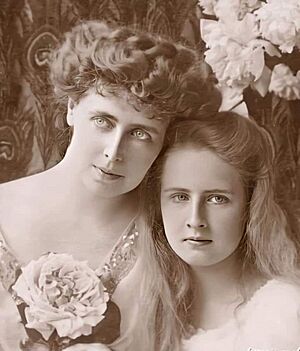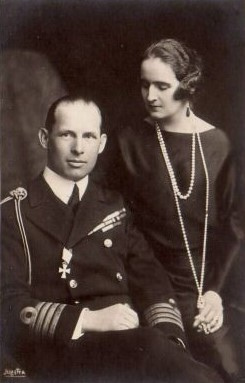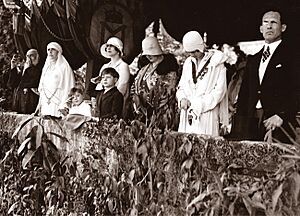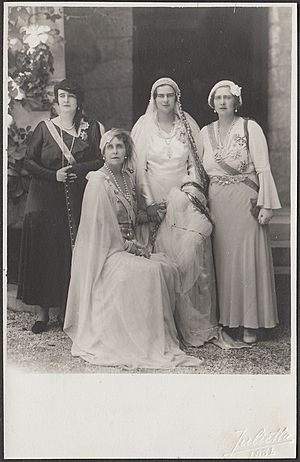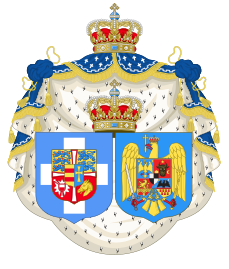Elisabeth of Romania facts for kids
Quick facts for kids Elisabeth of Romania |
|||||
|---|---|---|---|---|---|
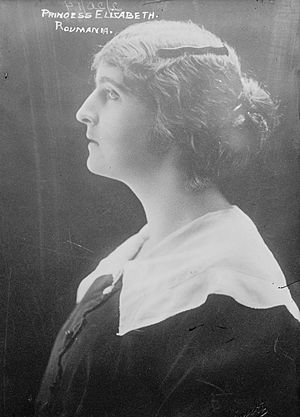 |
|||||
| Queen consort of the Hellenes | |||||
| Tenure | 27 September 1922 – 25 March 1924 | ||||
| Born | 12 October 1894 Peleş Castle, Sinaia, Kingdom of Romania |
||||
| Died | 14 November 1956 (aged 62) Villa Rose Alba, Cannes, France |
||||
| Burial | Hedinger Church, Sigmaringen, Baden-Württemberg, Germany | ||||
| Spouse | |||||
|
|||||
| House | Hohenzollern-Sigmaringen | ||||
| Father | Ferdinand I of Romania | ||||
| Mother | Marie of Edinburgh | ||||
| Religion | Eastern Orthodox | ||||
Elisabeth of Romania (born Elisabeth Charlotte Josephine Alexandra Victoria; 12 October 1894 – 14 November 1956) was a princess from Romania. She was part of the House of Hohenzollern-Sigmaringen. Through her marriage to King George II of Greece, she became Queen of Greece from 1922 to 1924.
Elisabeth was raised by her great-uncle, King Carol I of Romania, and his wife, Queen Elisabeth. She was a quiet person and often kept to herself. In 1921, she married Prince George, who was next in line to the Greek throne. She faced many political challenges in Greece after World War I.
When her husband became king in 1922, Queen Elisabeth helped many refugees. These people arrived in Athens after the Greco-Turkish War. However, the difficult political situation affected her health. She and her husband left Greece in December 1923. King George II was removed from power on 25 March 1924, when Greece became a republic.
Elisabeth and George II moved to Bucharest, Romania. Their marriage became difficult, and they divorced in 1935. Elisabeth was very close to her brother, King Carol II of Romania. She became very wealthy, partly thanks to financial advice. After her mother, Queen Marie, died in 1938, and King Carol II left the throne in 1940, Elisabeth became an important figure in Romania.
After World War II, she worked closely with the Romanian Communist Party. She was even called the "Red Aunt" because she seemed to support the communists against her nephew, the young King Michael I. However, her connections did not stop her from being sent out of the country when Romania became a communist state in 1947. She moved to Switzerland and then to Cannes, France. Before she died in 1956, she adopted a young artist named Marc Favrat.
Contents
Early Life
Elisabeth was the second child and first daughter of Crown Prince Ferdinand and Crown Princess Marie of Romania. Her mother was a member of the British royal family. Elisabeth was born on 12 October 1894 at Peleș Castle, Sinaia. She was named after her great-aunt, Queen Elisabeth of Wied.
Soon after her birth, Elisabeth and her older brother, Prince Carol, were raised by King Carol I and his wife. Her mother described Elisabeth as a "lovely solemn-faced child." As she grew up, Elisabeth became a quiet person. She was considered beautiful.
Marriage and Royal Life
An Unexpected Engagement
In 1911, Prince George of Greece met Elisabeth for the first time. He was next in line to the Greek throne and her second cousin. After the Balkan Wars, Prince George asked Elisabeth to marry him. However, she said no, thinking he was too short and too "English" in his ways.
During World War I, Elisabeth helped wounded soldiers. She visited hospitals daily, giving comfort to those hurt in the fighting.
In 1919, Elisabeth and her sisters, Maria and Ileana, went with their mother, Queen Marie, to the Peace Conference in Paris. The Queen hoped her daughters, especially Elisabeth, who was already twenty-five, would find husbands there.
After some months, they returned to Romania. On their way, they stopped in Switzerland. There, they met the Greek royal family, who were living in exile. King Constantine I had been removed from the throne during the war. Elisabeth met Prince George again. He was now the heir to the throne and asked her to marry him once more. This time, Elisabeth accepted.
At that time, Prince George's future was uncertain. He had been removed from the throne with his father. He was not allowed to stay in Greece and had little money.
Still, the engagement pleased both Elisabeth's and George's parents. Queen Marie of Romania was happy to have found a husband for her daughter. She invited Prince George to Bucharest to announce the engagement. Soon after he arrived, George learned that King Alexander I of Greece had died. This caused political problems in Greece.
Life as Crown Princess
On 5 December 1920, a vote allowed the Greek royal family to return home. King Constantine I, Queen Sophia, and Prince George returned to Athens on 19 December. Crowds cheered them in the streets.
A few weeks later, George returned to Romania to marry Elisabeth. Their wedding was a grand event in Bucharest on 27 February 1921. Soon after, on March 10, Elisabeth's brother, Crown Prince Carol of Romania, married George's sister, Princess Helen of Greece.
In Greece, Elisabeth found it hard to fit in with the royal family. Her relationship with Queen Sophia was especially difficult. Elisabeth was a quiet person, which some mistook for arrogance. Her in-laws often spoke Greek in front of her, and she had not yet learned the language well. Only King Constantine I and his sister, Grand Duchess Maria Georgievna, were kind to her. Even Prince George disappointed her, as she wished for a more loving relationship.
Elisabeth was unhappy not having her own home and living with her in-laws. She spent her husband's small income on redecorating their apartments. Also, her family was slow in paying her dowry. Her savings in Romania were lost due to bad investments.
Greece was facing a very difficult political situation because of the Greco-Turkish War. Elisabeth quickly understood that she had limited power in her new country. She joined the Red Cross, which was busy helping wounded soldiers from Anatolia. In her free time, she enjoyed gardening, painting, and drawing. She also tried to learn Modern Greek, which was very hard for her.
Elisabeth felt disappointed with her daily life. She became jealous of her sister Maria, who was married to King Alexander I of Yugoslavia. She also envied her sister-in-law Helen of Greece. The war made life for the Greek royal family very hard. Prince George's income was not enough for Elisabeth to buy the clothes and jewelry she wanted.
The relationship between Prince George and Elisabeth was already strained by the war. It became worse because they could not have children. Elisabeth became pregnant a few months after her wedding. However, she had a miscarriage during a trip to Smyrna. This deeply affected her. She then became sick with typhoid and pleurisy, and also suffered from sadness. She went to her family in Bucharest for comfort. Despite efforts from her mother and husband, her health and marriage never fully recovered.
Becoming Queen of Greece
Meanwhile, the Greek-Turkish War ended badly, forcing King Constantine I to step down. This made George the new king on 27 September 1922. However, the new king had little power. He and Queen Elisabeth could not stop the revolutionaries who took power. They watched with fear as Prince Andrew (the king's uncle) was almost executed.
Despite these hard times, Elisabeth tried to help Greece. To deal with the many refugees from Anatolia, the Queen had simple shelters built near Athens. To do this, she asked her family for help. She asked her mother, Queen Marie, to send wood and other materials.
However, Elisabeth found it harder and harder to live in Greece with its revolutionary mood. Her love for George II was gone. Her letters to her mother showed how much she worried about her future. Her letters also showed that she did not want to have children.
After an attempted uprising in October 1923, the royal couple's situation became even more uncertain. On 19 December 1923, King George II and his wife were forced to leave by the revolutionary government. They went to Romania. There, they learned that Greece had become a republic on 25 March 1924.
Return to Romania
Life in Exile
In Romania, George II and Elisabeth moved to Bucharest. King Ferdinand I and Queen Marie gave them a part of Cotroceni Palace. After a few weeks, they moved to a small house. The exiled Greek royal couple often visited the Romanian royal family and attended court events. But King George II felt bored in Romania.
Unlike her husband, Elisabeth was happy to be back in Romania. Her relationship with her mother was sometimes difficult, but they worked together on books. In the mid-1920s, Elisabeth drew pictures for her mother's book, The Country That I Love (1925). Her relationship with Crown Princess Helen of Romania (who was George II's sister) remained difficult. Elisabeth still felt jealous of her sister-in-law.
Life in exile, money problems, and not having children made the relationship between George II and Elisabeth worse. Elisabeth started to seek comfort in other ways. She began relationships with other people. She even became close to her brother-in-law, King Alexander I of Yugoslavia. Later, she became involved with her husband's banker, Alexandru Scanavi. He was made her personal assistant to keep things quiet.
In May 1935, Elisabeth heard that the Greek republic might fall, and the monarchy might return. Worried, she started divorce proceedings without telling her husband. George II was accused of "leaving the family home." Their marriage was ended by a Bucharest court on 6 July 1935, without him really being able to defend himself.
A Princess with Influence
After King Ferdinand I died in 1927, Romania went through a time of change. Crown Prince Carol gave up his right to the throne. His young son, Michael I, became king with a group of regents guiding him. However, many people supported Carol, who finally became king in 1930. Elisabeth was very close to her brother and strongly supported his return to Romania. She kept him informed about the country's politics when he was in exile.
Once Carol II was king, he had difficult relationships with his family. But he trusted Elisabeth, who was the only one in the royal family who accepted his partner. Thanks to money from her father, financial advice, and her good relationship with her brother, Elisabeth lived a grand life in Romania. In March 1935, she bought a large estate called Banloc. She also owned a mansion in Sinaia and a beautiful villa in Bucharest called Elisabeta Palace.
After her mother, Queen Marie, died in 1938, and Carol II left the throne in 1940, Elisabeth took on an important role in Romania. She supported her brother's policies. After Michael I returned to the throne and Marshal Ion Antonescu took power, Elisabeth stayed out of politics for a while.
However, from 1944, she started working with the Romanian Communist Party. She seemed to act against her nephew, King Michael I, who thought she was a spy. In early 1947, she hosted Marshal Tito at her Banloc estate. Tito had removed another of her nephews, King Peter II of Yugoslavia, from power. Elisabeth also helped fund groups fighting against her former brother-in-law, King Paul I, in Greece.
Elisabeth was not the only royal family member with communist ties. Her sister Ileana also had them, hoping her son might become king. Because of this, both princesses were called the "Red Aunts" of King Michael I.
Later Years
Despite her connections with the Romanian Communist Party, Elisabeth had to leave Romania. This happened after the country became the Romanian People's Republic on 30 December 1947. The new government gave her three days to pack. Her home, Elisabeta Palace, was searched. However, before she left, she managed to burn her old papers at her Banloc estate. On 12 January 1948, she left Romania with her sister Ileana on a special train. They lost much of their property when they were forced to leave.
Elisabeth first settled in Zurich and then in Cannes, France, at a place called Villa Rose Alba. She became close to a young artist named Marc Favrat. She wanted to marry him, but her cousin refused to give him a royal title. So, Elisabeth decided to adopt him instead. She did this three months before she died on 14 November 1956.
Her body was taken to the Hohenzollern-Sigmaringen family burial place, the Hedinger Kirche in Sigmaringen.
Archives
Young Princess Elisabeth's letters to her grandfather, Leopold of Hohenzollern-Sigmaringen, are kept in the Hohenzollern-Sigmaringen family archive. This archive is in the State Archive of Sigmaringen (Staatsarchiv Sigmaringen) in Sigmaringen, Germany.
Arms and Monogram
See also
 In Spanish: Isabel de Rumania para niños
In Spanish: Isabel de Rumania para niños


